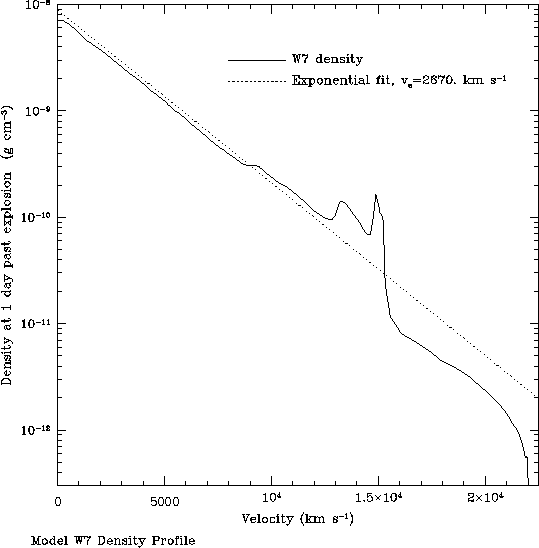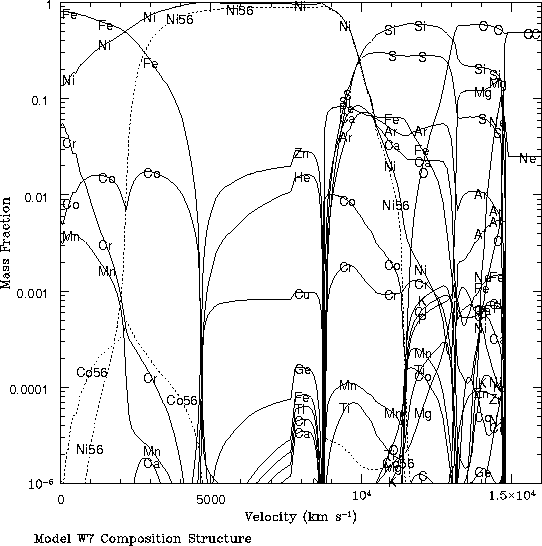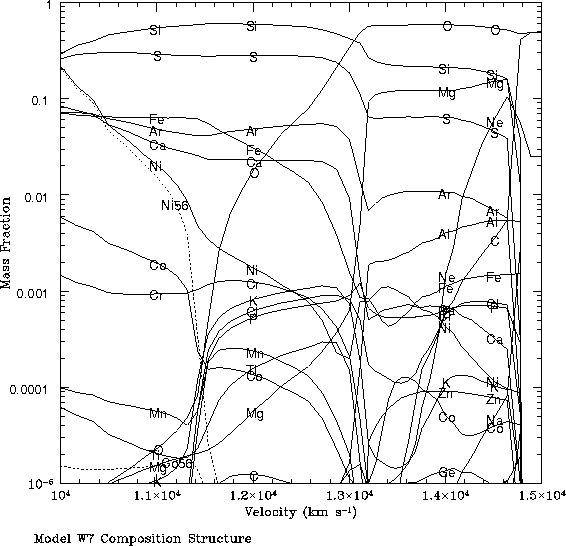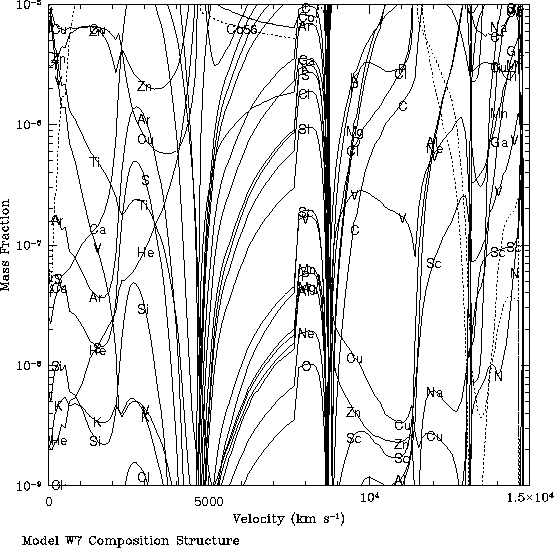Model W7
 Model W7
(Nomoto et al. 1984;
Thielemann et al. 1986)
is a pure deflagration model of a SN Ia.
It has been a standard fiducial model for a SN Ia for many years because it does some
things right and has detailed nucleosynthesis unlike most SN Ia models which just do
simplified nucleosynthesis to get the kinetic energy about right.
Model W7
(Nomoto et al. 1984;
Thielemann et al. 1986)
is a pure deflagration model of a SN Ia.
It has been a standard fiducial model for a SN Ia for many years because it does some
things right and has detailed nucleosynthesis unlike most SN Ia models which just do
simplified nucleosynthesis to get the kinetic energy about right.
W7, in fact, is about the only pure deflagration model that is plausible for SNe Ia.
Most of the 1-dimensional ones have intermediate-mass element layers which are just too
narrow in velocity space.
The 3-dimensional ones, in contrast, mix in blobs (not microscopically) of elements
everywhere which is also inconsistent with real SNe Ia.
W7 exhibits the quasi-exponential density profile that is typical of hydrodynamic SN Ia models.
Below I've fitted the W7 density profile (see Fig. 1 below)
to an exponential using the net kinetic energy
and mass of W7 in the formulae of
Jeffery (1999).
The mass is 1.3776068 M_Sun (which is obtained from the model after scaling the density
to the mass specified in the files: the scaling was needed since the data files are
not entirely consistent) and the kinetic energy was 1.172189777 foe (1 foe = 1.e+51 ergs) which
is what the scaled model actually yields:
Nomoto et al. (1984)
say the kinetic energy was 1.3 foe, but that's not what the data file yields.
Figures 2 through 4 give the time-zero composition structure of W7.
Time zero is right after explosion before the composition begins changing through
radioactive decay.
The most important decay chain is Ni-56 to Co-56 to Fe-56
with half-lives of 6.077(12) days and 77.27(3) days
for the first and second decays, respectively
(Firestone & Ekstroem 2004).
Figure 2 is the overall composition of the most abundant elements.
Figure 3 shows the complicated intermediate-mass element layer in detail.
Figure 4 shows the abundances of the low abundance species: i.e., the lower
depths of the composition.
Radioactive Ni-56 and Co-56 are displayed by dotted lines.
See Supernova Radioactive Species (in non-existent preparation).
For comparison, the solar composition is given by
Solar Composition.
The actual model W7 data obtained years ago from either Ken Nomoto or Friedl Thielemann
consists of two files.
The full data file w7.dat (slightly modified by me) and the
summary composition file w7_abund.dat (also slightly modified by me).
The w7.dat file can be read using subroutine w7 in
read-in library readin.f, but this library depends on my
general library aalib and needs
a makefile.
The reader might need some help to make these fortran-95 program units work.
-

The density profile for the homologous phase and an exponential fit.
Postscript plot of the model W7 density profile.
-

The overall composition at time zero (not counting the minute explosion phase).
Postscript plot of the model W7 composition structure.
-

The intermediate-mass element layer composition at time zero (not counting the minute explosion phase).
Postscript plot of the model W7 composition structure.
-

The low abundance species composition at time zero (not counting the minute explosion phase).
Postscript plot of the model W7 composition structure.




 Model W7
(Nomoto et al. 1984;
Thielemann et al. 1986)
is a pure deflagration model of a SN Ia.
It has been a standard fiducial model for a SN Ia for many years because it does some
things right and has detailed nucleosynthesis unlike most SN Ia models which just do
simplified nucleosynthesis to get the kinetic energy about right.
Model W7
(Nomoto et al. 1984;
Thielemann et al. 1986)
is a pure deflagration model of a SN Ia.
It has been a standard fiducial model for a SN Ia for many years because it does some
things right and has detailed nucleosynthesis unlike most SN Ia models which just do
simplified nucleosynthesis to get the kinetic energy about right.